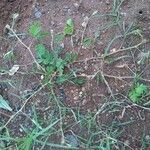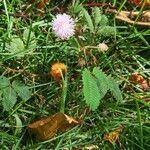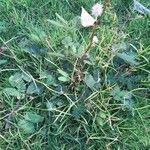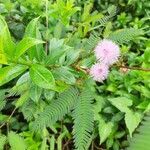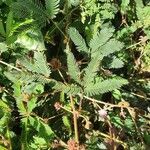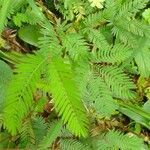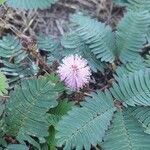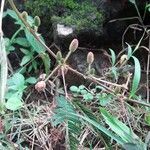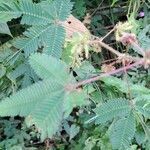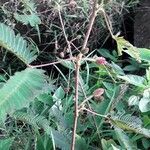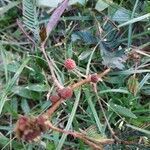Annual or perennial, sometimes subshrubby herb, erect to scrambling, sometimes rooting at the nodes, up to 1 m high; stems glabrous to densely hispid, armed by recurved prickles. Leaves subdigitately pinnate, petiole furrowed, hispid, (2.5-)3-5.5 cm, without prickles at the junctions of the pinnae, but sometimes with some recurved prickles in between; pinnae 2 pairs, rachis furrowed, (1.5-)2.5-6(-7) cm, hirsute; leaflets 12-25 pairs per pinna, oblong to subfalcate, 6-15 by 1.2-3 mm, upper surface glabrous, lower slightly hispid, margins setulose. Inflorescences consisting of axillary, pedunculate, solitary or paired glomerules. Flowers sessile, bisexual, tetramerous, lilac, pink or bluish purple. Calyx inconspicuous, c. 0.1 mm. Corolla narrowly campanulate, 1.9-2.3 mm; lobes broadly ovate-oblong, 0.5-0.8 mm, obtuse to rounded at the apex. Stamens 4. Ovary glabrous, 0.3-0.6 mm. Pods clustered, straight, oblong, 1.5-1.8 by 0.4 cm, densely setose, prickly on the margins only. Seeds light brown, suborbicular to broadly elliptic, flattened, 2.5-2.9 by 2-2.3 mm.
Herbs, diffuse, shrubby, to 1 m tall. Stems cylindric, branched, with reflexed bristles and scattered, curved prickles. Stipules lanceolate, 5-10 mm, bristly; pinnae and leaflets sensitive; pinnae usually 2 pairs, digitate, 3-8 cm; leaflets 10-20 pairs, linear-lanceolate, 6-15 × 1.5-3 mm, abaxially slightly hispid, adaxially glabrous, margin ciliate, apex acute. Heads solitary or 2, axillary, globose, ca. 1 cm in diam.; peduncle long; bracts linear. Flowers numerous, pink, small. Calyx minute. Corolla campanulate; lobes outside pubescent. Stamens 4, exserted. Ovary shortly stipitate, glabrous; ovules 3 or 4; style filiform; stigma small. Legumes arranged in a star, slightly recurved, flat, oblong, 1-2 cm × ca. 5 mm, consisting of 3-5 1-seeded segments which fall away from persistent, bristly sutures. Seeds light brown, ovoid, ca. 3.5 mm. Fl. Mar-Oct, fr. May-Nov. 2n = 52*.
Annual or perennial herb, sometimes woody below, up to about 1 m. high, often prostrate or straggling.. Stems ± sparsely armed with prickles about 2.5–5 mm. long, in addition varying from densely hispid to subglabrous.. Leaves sensitive, unarmed; petiole 1.5–5.5 cm. long; rhachis very short, so that the 2 (rarely only 1) pairs of pinnae are subdigitate; leaflets 10–26 pairs, linear-oblong, 6–12.5(–15) mm. long, 1.2–2.75(–3) mm. wide; venation diverging from and not nearly parallel with midrib; margins setulose.. Flowers lilac or pink, in shortly ovoid pedunculate heads about 1–1.3 cm. long and 0.6–1 cm. wide, 1–4(–5) together from axils.. Calyx minute, about 0.2 mm. long.. Corolla 2–2.25 mm. long.. Stamens 4.. Pods clustered, densely setose-prickly on margins only, 1.0–1.8 cm. long, 0.3–0.5 cm. wide (excluding the prickles).
Trailing, climbing or subshrubby herb to 1 m high; branches glabrous to densely hispid, armed with pair of stout, recurved prickles at or just below nodes as well as scattered internodal prickles. Leaves subdigitately pinnate; pinnae 1-or 2-jugate, lacking prickles or rarely with few on rachis; leaflets 12–25-jugate, oblong, 6–15 mm long; margins and sometimes lower surface of leaflets setulose. Inflorescences solitary or paired, capitate; heads globular to widely ellipsoid. Flowers pink or mauve, 4-merous, subtended by linear, marginally setose bracteoles; calyx subobsolete; corolla glabrous or with puberulous lobes. Pods oblong, straight, 1.5–1.8 cm long, c. 4.5 mm wide, clustered, prickly on margins. Seeds subcircular to elliptic in outline, flat, 2.5–3 mm long.
A low spreading shrub. The branches are hairy and prickly. The leaves are sensitive to touch. The leaves are 2.5 cm long and the stalks are grooved and prickly. There re 1-2 pairs of pinnae with 12-20 pairs of leaflets on each. These are 6-8 mm long and 5-6 mm wide. The flowers are in almost round heads. They are yellow on stalks about 2 cm long. The heads are 6-8 mm across. They occur singly or in pairs along the branches. The fruit is a broad, flat, curved pod. It is 12-18 mm long.
Leaves sensitive, unarmed; petiole 1·5-5·5 cm. long; rhachis very short, so that the 2 (rarely only 1) pairs of pinnae are subdigitate; leaflets 10-26 pairs, 6-12·5(15) x 1·2-2·75(3) mm.; venation diverging from and not nearly parallel with the midrib; margins setulose.
Annual or perennial herb, sometimes woody below, up to c. 1 m. high, often prostrate or straggling; stems ± sparsely armed with prickles c. 2·5-5 mm. long, in addition varying from densely hispid to subglabrous.
Flowers lilac or pink, in shortly ovoid, pedunculate heads c. 1-1·3 x 0·6-1 cm., 1-4(5) together from the axils.
Pods clustered, 1-1·8 x 0·3-0·5 cm. (excluding the prickles), densely setose-prickly on the margins only.
Calyx minute, c. 0·2 mm. long.
A straggling prickly plant
Corolla 2-2·25 mm. long.
Stamens 4.
